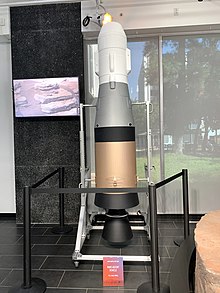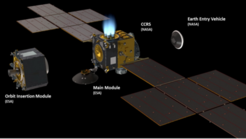NASA–ESA concept
The NASA-ESA plan is to return samples using three missions: a sample collection mission (Perseverance), a sample retrieval mission (Sample Retrieval Lander + Mars ascent vehicle + Sample Transfer arm + 2 Ingenuity class helicopters), and a return mission (Earth Return Orbiter).[1][2][3] The mission hopes to resolve the question of whether Mars once harbored life.
Sample collection
The Mars 2020 mission landed the Perseverance rover, which is storing samples to be returned to Earth later. After consideration, it was decided that given Perseverance's expected longevity, it will be the primary means of transporting samples to Sample Retrieval Lander (SRL).

Sample retrieval

(Artwork; 27 July 2022)
The sample retrieval mission involves launching a sample return lander in 2028 with the Mars Ascent Vehicle and two Ingenuity class sample recovery helicopters, both of which will be collecting the samples with a tiny robotic arm as a backup for Perseverance. The rover and helicopters will transport the samples to the SRL lander. SRL's EAS-built sample transfer arm will be used to extract the samples and load them into the Sample Return Capsule in the Ascent Vehicle.[1] It is planned to land near the Octavia E. Butler Landing site in 2029.
Mars Ascent Vehicle (MAV)


MAV is a 3 m (9.8 ft) long, two-stage, solid-fueled rocket that will deliver the collected samples from the surface of Mars to the Earth Return Orbiter. Early in 2022, Lockheed Martin was awarded a contract to partner with NASA's Marshall Space Flight Center in developing the MAV.[5] It is planned to be catapulted into the air just before it ignites, at a rate of 16 feet (5 meters) per second, to remove the odds of wrong liftoff like slipping or tilting of SRL under rocket's shear weight and exhaust at liftoff. This Vertically Ejected Controlled Tip-off Release (VECTOR) system adds a slight rotation during launch, pitching the rocket up and away from the surface.[6] MAV would enter a 380 km orbit.[7] It will remain stowed inside a cylinder on the SRL and will have a thermal protective coating. The rocket's first stage (SRM-1) would be run by a single modified STAR-20 engine burning for 70 seconds, while the second stage (SRM-2) would have a single modified STAR-15G engine burning for another 25 seconds.[8] They would be separated by a coast phase, after which the sample container would be released in orbit. As of early 2022, the second stage is planned to be spin-stabilized to save weight in lieu of active guidance, while the Mars samples will result in an unknown payload mass distribution.[7]
MAV is scheduled to be launched in 2028 on board the SRL lander.[1]
Sample return
Earth Return Orbiter (ERO)
ERO is an ESA-developed spacecraft.[9][10] It includes the NASA-built Capture and Containment and Return System to rendezvous with the samples delivered by MAV in low Mars orbit (LMO). ERO orbiter is planned to weigh ~6,000 kg (13,000 lb) and has solar arrays that have a wingspan of more than 40 m (130 ft) (these are some of the largest solar panels ever launched into space).
ERO is scheduled to launch on an Ariane 64 rocket[11] in 2027 and arrive at Mars in 2028,[1] using ion propulsion and a separate propulsion element to gradually reach the proper orbit and then rendezvous with the orbiting sample. The MAV's second stage will have a radio beacon that will give controllers the information they need to get the ESA Earth Return Orbiter close enough to the Orbiting Sample to see it through reflective light and capture it for return to earth. The orbiter will retrieve and seal the canisters in orbit and use a NASA-built robotic arm to place the sealed container into an Earth-entry capsule. It will raise its orbit, release the propulsion element, and return to Earth during the 2033 Mars-to-Earth transfer window.
Earth Entry Vehicle (EEV)
The Capture/Containment and Return System (CCRS) would stow the sample in the EEV. EEV would return to Earth and land passively, without a parachute. The desert sand at the Utah Test and Training Range and shock absorbing materials in the vehicle were planned to protect the samples from impact forces.[12][13][10] EEV is scheduled to land on Earth in 2033.[14]
- ^ a b c d Foust, Jeff (27 March 2022). "NASA to delay Mars Sample Return, switch to dual-lander approach". SpaceNews. Retrieved 28 March 2022.
- ^ "Future Planetary Exploration: New Mars Sample Return Plan". 8 December 2009.
- ^ "Mars sample return". www.esa.int. Retrieved 2022-01-03.
- ^ Chang, Kenneth (27 July 2022). "NASA Will Send More Helicopters to Mars - Instead of sending another rover to help retrieve rock and dirt samples from the red planet and bring them to Earth, the agency will provide the helicopters as a backup option". The New York Times. Retrieved 28 July 2022.
- ^ "NASA Selects Developer for Rocket to Retrieve First Samples from Mars". NASA Press Release 22-015, Feb 7 2022. 7 February 2022. Retrieved 2 July 2022.
- ^ "NASA Begins Testing Robotics to Bring First Samples Back From Mars". NASA Jet Propulsion Laboratory (JPL). December 13, 2021. Retrieved 2022-08-02.
- ^ a b Yaghoubi, Darius; Maynor, Shawn. "Integrated Design Results for the MSR SRC Mars Ascent Vehicle" (PDF). NASA Technical Reports Server. Retrieved 26 April 2022.
- ^ "identify this object - What are these two little valve stem-like projections from the Northrop Grumman STAR 15G upper stage rocket motor? Why doesn't the STAR 20 have them?". Space Exploration Stack Exchange. Retrieved 2022-12-22.
- ^ "Airbus to bring first Mars samples to Earth: ESA contract award | Airbus". www.airbus.com. 28 October 2021. Retrieved 2021-12-14.
- ^ a b Cite error: The named reference
Planetary Decadal 2010was invoked but never defined (see the help page). - ^ "Earth Return Orbiter's first step to Mars". Airbus (Press release). 15 June 2021. Retrieved 28 March 2022.
- ^ Kellas, Sotiris (March 2017). "Passive earth entry vehicle landing test". 2017 IEEE Aerospace Conference. Big Sky, MT, USA: IEEE: 1–10. doi:10.1109/AERO.2017.7943744. hdl:2060/20170002221. ISBN 978-1-5090-1613-6. S2CID 24286971.
- ^ Cite error: The named reference
Denver Museumwas invoked but never defined (see the help page). - ^ Gebhardt, Chris; Barker, Nathan (2021-06-04). "Mars Ascent Vehicle from Northrop Grumman takes shape for Mars Sample Return mission". NASASpaceFlight.com. Retrieved 2021-08-27.






